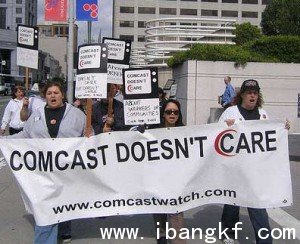Today’s guest blogger is Jason Mikula , who has a wide variety of experience in the Internet marketing space, in the areas of search engine marketing, social media management, and pay per click. He spent a year and a half doing community development work in the West Indian nation of St. Lucia, which taught him that you’re never done learning and need to be flexible to cope with unexpected situations and obstacles (like landslides, hurricanes, power outages, and, occasionally, theft).
I recently took a look at Apple’s approach to customer service. My experience with Apple reinforced my confidence in them as a company and increased the likelihood I’ll buy a product from them in the future. My experiences with the companies in today’s post were not nearly as positive.

Image via First Coast DNS
Comcast: Using Twitter for Good, Not Evil
Of the three companies in this post, Comcast actually delivered the best customer service. Much has already been written about Comcast’s customer service via Twitter (here and here), so I’m just going to relate my personal story.
I moved in to a new apartment and, since it’s the only option, called Comcast to have their service installed. They were able to get someone out within a matter of days, he installed the modem, and everything seemed fine. After about two weeks, the service would intermittently be down – sometimes for hours at a time. I tweeted @ComcastCares and received a reply from @ComcastMelissa within minutes. She looked up my account and was able to schedule a technician to come by later the same day.
The tech determined it was a problem with the cable running in from outside. He replaced a portion of the cable, the connectors, and the modem. This seemed to solve the problem, and Comcast even gave me a $20 credit on my statement for the trouble.
Unfortunately, the situation basically repeated itself about two weeks later. A Comcast technician who was at the building trying to install TV at a neighboring apartment accidentally disconnected our Internet. I complained again via Twitter (on a Sunday) and again received a prompt reply from @ComcastMelissa. I ended up calling and speaking with a different rep over the phone, and an appointment was scheduled for the following day. The problem was fixed quickly enough and, again, I received a $20 credit on my statement.
My interaction with Comcast via Twitter was both effective and genuine – I received a reply not from some generic corporate account with a Comcast logo, but from an account I could readily identify as a human, which even sported a photo of @ComcastMelissa and her son.
 Delta Airlines: Present, but Robotic
Delta Airlines: Present, but Robotic
My experience with Delta was less pleasant. Because of an illness, I was unable to use a portion of an airline ticket I had purchased. I had documentation stating this that I submitted to Delta in order to request a refund for the unused portion of the fare.
After several phone calls and emails, I resorted to what Consumerist refers to as the “executive email carpet bomb” – I emailed every C-suite address I could find.
Ultimately this worked – a few days later, I received an email from Delta’s customer care department. The unused portion of my ticket was to be credited back to me, and I received a $100 transportation credit on Delta.
When I felt like it was taking too long for the credit to appear on my statement, I tweeted @Delta. I did get a response informing me credits can take two full billing cycles to appear, from the @Delta account, sporting the Delta logo. It sounded like the tweet had been copied and pasted from a corporate-approved script – no indication a human was present.
IXWebhosting: Total Disaster
My experience with this company is among the worst customer service I have ever experienced. I opened an account with them about a month ago, which is where this blog is hosted. Within the first month, I experienced multiple service outages, with one of them lasting nearly three days.
When I opened service tickets to complain, I received no response or poorly written responses that contained little information about the cause of the problem or anticipated length of disruption. Calling on the phone didn’t help either. Ultimately, I monitored their status blog, which revealed that the longest outage was caused by a botched upgrade to one of their servers.
After opening four different service tickets requesting the issue be fixed or a full-refund, I finally received a phone call from a customer service rep at IXWebhosting. He apologized for the poor service, explained what had happened, and offered a three-month service credit.
Though I have little faith in the quality of their hosting and their customer service, faced with the chore of transferring my site and domains to a new server, I’m giving them a second chance. If I experience any further downtime with them, I will be seeking a full refund and canceling my service.#p#分页标题#e#
Customer Service Needs to be Personalized and Human
Although I’m displeased generally with the quality of Comcast’s service, they get how to deploy social media as a customer service channel. Social media emphasizes individual connections and personal attention, and that’s what Comcast delivers when an actual person, with a photo, replies to your concern immediately and takes it seriously. They make you feel like you have a personal ally within their organization.
On the other hand, companies that poorly execute social media fail to make customers feel like they’re getting personalized, individual attention and risk further alienating their customers.
Tools for Monitoring Social Media for Customer Service Complaints
There are a plethora of tools for monitoring the social web, a few of which I’ll list here. Check out a complete list of social media monitoring tools here.
Google Alerts, Google Blog Search
Google Alerts is a tool not just for monitoring social media platforms, but the entire web, including blog posts, press releases, forums, and so on. Simply enter keywords or phrases, select how you want to receive the information, and you’re all set. Google Blog Search lets you search blog entries across the blog for keywords or phrases.
Twitter Advanced Search
Twitter’s advanced search functionality allows you to look for tweets by searching for words or phrases, hashtags, people, geolocations, dates, attitudes, and many more options. A quick way to see if people are tweeting about you, your brand, or your product.
Socialmention
Socialmention bills itself as “real-time social media search and analysis”. Type in your query and choose what types of sites you want to search, and Socialmention delivers the results.
Hootsuite
I would categorize Hootsuite more as a social media management tool than a monitoring service, but it does allow you to manage all your social media accounts from a single dashboard. You can set up different panes to track things like @ mentions or direct messages from Twitter.
There are also pay tools to help with tracking social media, like Lithium (formerly Scoutlabs) and Radian6, which provide enterprise-level solutions for social media monitoring and alerts.
What do you think? What has been your experience with seeking customer service through Twitter or other social networks? Please share your experience in the comments section below.
Jason Mikula works for a variety of clients, on-site, locally, and remotely, creating marketing plans, writing content, conducting email marketing campaigns, managing social media accounts, setting up analytics, and producing reports.For more information about Jason, visit http://jasonmikula.com/about-jason-mikula/
上一篇:Guest Blogger Joanna Brandi Share: 7 Tricks to Stay Positive
下一篇:Guest Blogger Edward Caulfield Says: “You Killed M